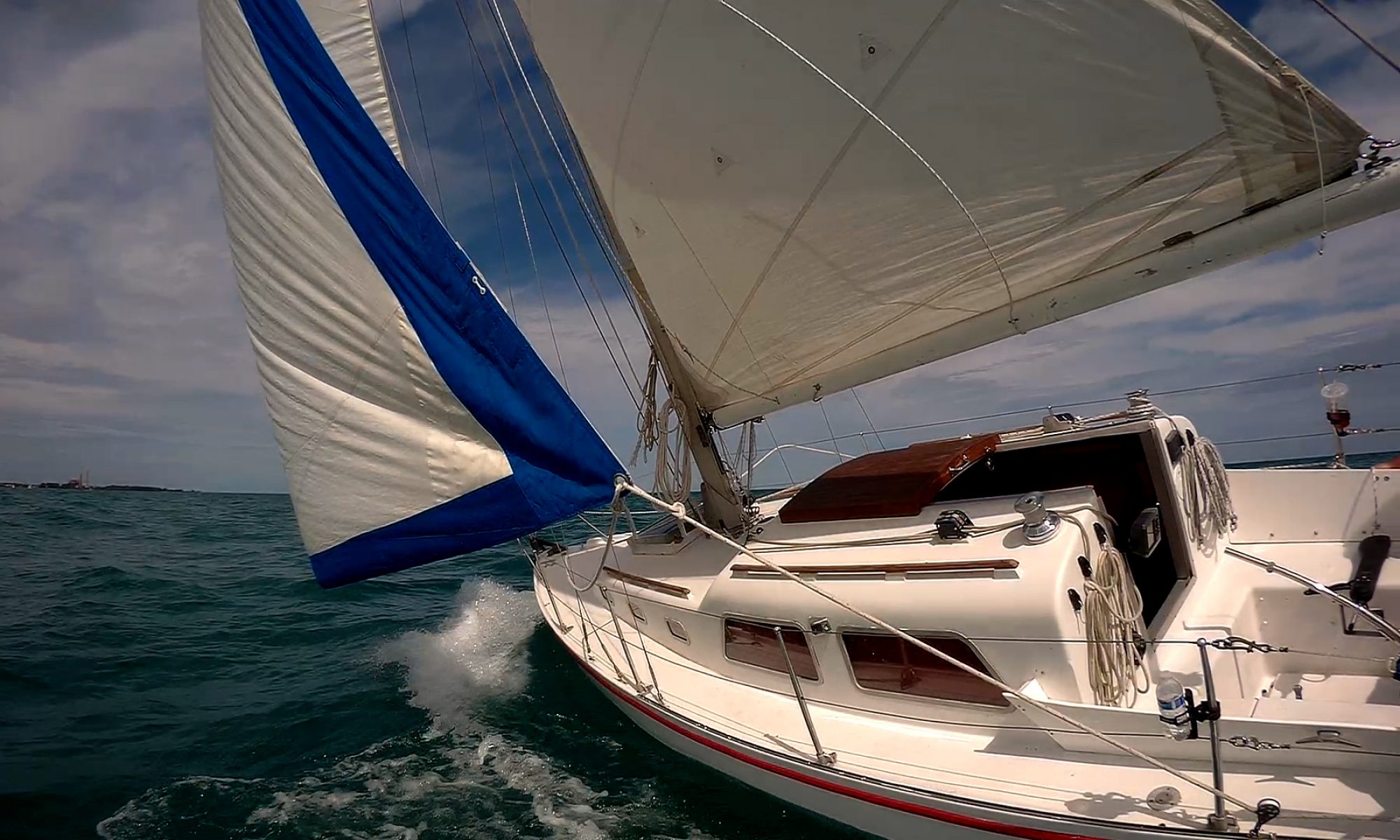Removed old depth transducer, installed new Garmin Intelliducer depth transducer, reinstalled hull ground plate and reinstalled fuel tank.
24-April-2016, Installed new TACO rubrail
We installed a TACO rigid vinyl rub rail kit my dad bought in 2010 before giving the boat to my brother and me.
Installation required drilling and counter-sinking a hole every 6 inches along the length of the rub rail and then using the included screws to attached it to the boat.
Each 30 foot length of rub rail is package in a 24″ square “pizza box” and the hardest part of the job is straightening out the tightly coiled rub rail. We had to use a heat gun a lot.
17-April-2016, Prepping for the new rubrail installation and installing the new masthead
On Saturday 16-April my brother removed all the old bolts that held the old rubrail in place and washed the area that was under the old rubrail. Simple Green, water and a soft scrub brush.

All clean under where the old rubrail was
On Sunday 17-April we filled in all the bolt holes with 3M 5200 and put a bead of the 5200 between the hull and deck joint all around the boat.

Old bolt holes all filled in
We also dry fit the new rub rail to see how it would look. It will look marvelous!

Dry fitting the new rubrail
We also installed the new masthead with the new Garmin GWS wind system. The GWS includes wind direction, wind speed, outside temperature and barometric pressure. The new masthead also supports the VHF antenna, a AM/FM antenna, the Windex and anchor light.
In addition to the GWS wind system, our Gamin N2K system also includes a GMI multi-function display, GPSMAP 421 chartplotter and we plan to add a Garmin Intelliducer for depth. We plan to flush mount the GMI and mount the chartplotter on a swing-arm. I had an aluminum swing-arm that came as an accessory with a small flat screen TV that fits the chartplotter perfectly. We mounted the swing arm as well.

Swing-arm for the chartplotter folds up out of the way when not in use.
3-April-2016, Dropping new cables in the mast and removing the rubrail
We found a rats nest of old cables in the mast that caused a problem in dropping the new cables. So, we opened up the holes at the bottom of the mast so we could pull out to old cables. I went up the mast again to drop the new cables.

Rats nest of old cables removed from the bottom of the mast

new cables dropped into the mast.
We also removed the rubrail in preparation for installing a new one. The rubrail looked to be original (49 years old) and was rotted in several areas. Pulling it off was not to hard.

Removing the old rubrail
25-March-2016, Installing ladder brackets, stove gimbal and climbing the mast
Installed new ladder brackets. The original ones we installed last year required bolts to be used to secure the ladder. It took too long to get the ladder in place and the risk of dropping a bolt into the water was high. So I designed a new system with a “keyhole slot” to make it much faster.

Shoulder bolts on the ladder for use with the keyhole design brackets
We also installed the gimbal I designed for use with the “vintage” Punker Marine alcohol stove I bought on ebay.
I also climbed the mast to remove old cables and drop a new “fish line” in preparation for installing new cables. I updated the “climbing board” with a new cam cleat and it worked perfectly.
12-March-2016, Removed the winter tarp and climbed the mast for the first time.
We removed the winter tarp and frame. Reinstalled the lifelines and climbed the mast. It was the first time I had been to the top of the mast. I saw a device on YouTube (https://youtu.be/ycQm_ApCrUI) that looks like it would make climbing the mast a fairly easy process. I fabricated one from parts in my junk pile, but unfortunately the cam cleat I used did not work properly and I was not able to use it when climbing the mast.
5-December-2015, Winter project – Remove the fuel tank
One of our winter projects is to remove and clean the fuel tank. It looks to be original which means it has been in place 47 years and probably has a lot of junk in the bottom. We might also add a fuel level sensor. Today we removed it and took it to a do-it-yourself car wash to rinse it with degreaser and then wash it with a high pressure hose. The next step will be to bead blast the outside to clean it up and find a fuel level sensor.

Fuel tank sitting in cockpit locker

Top of the fuel tank (fill hose) sitting in cockpit locker

Top of the fuel tank (vent hose left and fuel hose to engine right) sitting in cockpit locker

Fuel tank taken from the cabin side when we rebuilt the galley
1-November-2015 – Installing the winter cover
We installed the PVC frame and winter cover/tarp.
25-October-2015 – Last sail of the 2015 season
It was the last sail of the 2015 season and we brought “Thanks Dad” over to the boat yard afterward to be hauled out for the winter.
When we arrived at the marina the winds were blowing at 2 knots with gusts to 5. At that point we anticipated not sailing and just bringing the boat to the boat yard. As we pulled out of the slip the winds picked up to about 10 knots and we had a pleasant sail.
24-October-2015 – Winds gusting 25 – 30 knots! Fun ride.
Fun fall sail. With winds gusting to 30 knots, waves to 4 feet, spray coming over the bow and temps in the 50’s, we ended up having to wear our foul weather gear.










